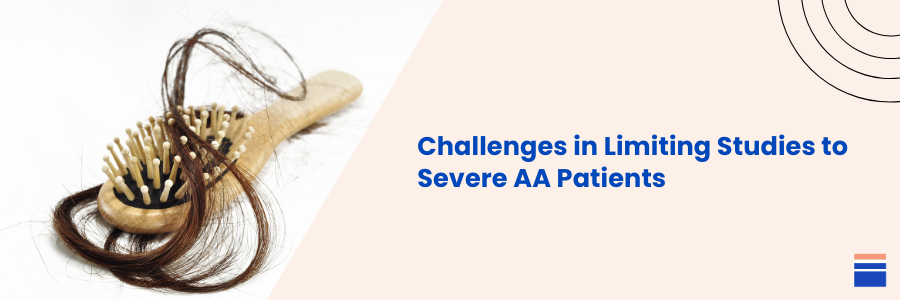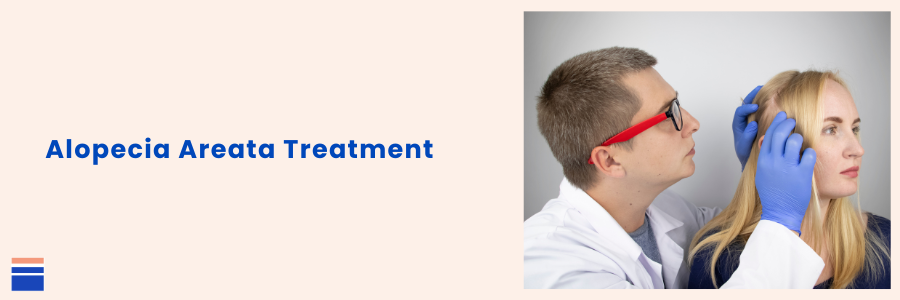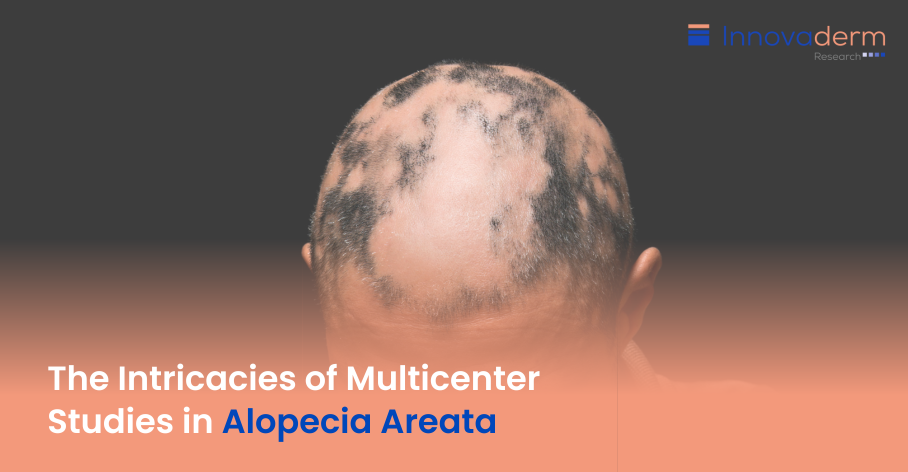The Intricacies of Multicenter Studies in Alopecia Areata
Table of contents
- Alopecia Areata: The Condition
- The Severity of Alopecia Tool (SALT)
- Participation of Severe AA Patients in Clinical Trials
- Challenges in Limiting Studies to Severe AA Patients
- Implementing a Cap for Balanced Trials
- AA Treatment
Alopecia Areata: The Condition
Alopecia Areata (AA) is a medical condition characterized by hair loss that occurs in patches on the scalp or other parts of the body. The hair loss is not uniform and can vary greatly from patient to patient, with some experiencing minimal hair loss and others losing hair across their entire scalp or body.
AA is classified as an autoimmune disorder. In the case of AA, the immune system targets the hair follicles, leading to hair loss. The exact cause of this immune response is still not fully understood, but it is believed to involve a combination of genetic and environmental factors. It can affect anyone, regardless of their gender or age.
The Severity of Alopecia Tool (SALT)
There are varying degrees of hair loss due to AA, which can be measured using the Severity of Alopecia Tool (SALT). The SALT score is a crucial tool in both the diagnosis and the monitoring of AA.
The SALT score is calculated based on the percentage of hair loss on the scalp. The scalp is divided into 4 quadrants, each area is assigned a proportion of the total scalp area, and the percentage of hair loss in each area is assessed. These percentages are then used to calculate the overall SALT score up to 100.
A higher SALT score indicates a greater degree of hair loss. For instance, a SALT score of 0 would indicate no hair loss, while a SALT score of 100 would signify total hair loss on the scalp. Therefore, the SALT score provides a quantitative measure of the severity of AA in a patient.
It is important to note that the SALT score is not just a diagnostic tool, but also a valuable instrument for tracking the progress of the disease and the effectiveness of treatments. By comparing SALT scores over time, clinicians can assess whether a patient’s condition is improving, worsening, or remaining stable. This can guide treatment decisions and provide a clear picture of a patient’s journey with AA.
The assessment criteria employed by SALT are subjective and visual, and sometimes require the principal investigator (PI) to move strands of hair out of the way to examine the scalp of the patient. Using photos of the scalp is a common practice, but it has limitations, because when another evaluator assesses SALT score solely based on pictures of a patient’s scalp, there might be a variation compared to the trained investigator’s live, in-person evaluation.
Of course, the PI’s assessment is the one that truly matters, but the best approach is to use photographs to add value by potentially detecting human error in the evaluation, such as the inversion of a score or a miscalculation of the final SALT score. The intention is not to replace the PI but to enhance the accuracy of the evaluation process. Photography in this type of trial also provides the study sponsor with publishable visual data of the hair growth progress during the trial.
Participation of Severe AA Patients in Clinical Trials
Patients with higher SALT scores, indicating more severe hair loss, often show a higher interest in participating in clinical trials. There are several reasons for this:
1. Seeking Solutions
Patients with severe AA have often exhausted standard treatment options without satisfactory results. Therefore, they may be more motivated to participate in clinical trials.
2. Availability
Patients with severe AA may be more available for clinical trials. This could be due to the fact that the impact of the condition on their quality of life is significant, making them more willing to invest time in potential treatment options.
3. Awareness
Patients with severe AA are often more aware of ongoing trials. This could be because they are more likely to actively seek information about their condition and potential treatments. They might follow medical news, be part of patient advocacy groups, or have healthcare providers who inform them of research opportunities.
Challenges in Limiting Studies to Severe AA Patients

However, studies cannot be limited to only these patients. This is for 2 main reasons. Firstly, severe AA, being at the extreme end of the spectrum, may not provide a comprehensive understanding of the disease’s progression and treatment response.
Secondly, severe AA cases are relatively rare compared to mild or moderate ones, thus limiting the pool of potential study participants.
Another important consideration is the difficulty of hair regrowth when hair loss exceeds a certain level. This is particularly true in severe AA cases where the immune system causes extensive damage to the hair follicles. Such damage can be so severe that the follicles lose their ability to produce new hair strands. As a result, treatments that might effectively stimulate hair growth in milder cases may not work as well in severe cases.
When testing a drug in a proof-of-concept (POC) study for AA, it is also essential to include patients with moderate severity. This allows the study to determine if the drug can stimulate hair regrowth, providing a more comprehensive understanding of its potential effectiveness across different stages of the disease.
Implementing a Cap for Balanced Trials
A common practice is to implement an enrollment cap to maintain balance. This cap is designed to limit the number of patients with the most severe forms of AA, namely Alopecia Totalis or Universalis, which are represented by a SALT score of 100.
However, the study is not limited to just these severe cases. The rest of the patients are selected from the lower SALT ranges, typically starting from SALT 50. This range represents patients with moderate to severe hair loss, but not total or near-total hair loss. Including these patients ensures that the trial captures a broad spectrum of disease severity, which is vital for understanding the drug’s effectiveness at different stages of AA.
This approach of implementing a cap and including lower SALT range patients ensures a balanced trial. It prevents the over-representation of any one group and allows for a more comprehensive understanding of the treatment’s effectiveness across different severity levels. It provides a more accurate and generalizable understanding of the potential treatment, ultimately leading to better therapeutic strategies for all AA patients.
When a study is conducted across multiple sites, communication becomes key. It is essential to coordinate with all involved sites to maintain this balance in participant severity by halting enrollment once a specific cap is met. This approach allows for effective management of expectations and collection of the most relevant data.
AA Treatment

Until 2 years ago, the landscape of treatments for AA was quite barren in the United States and Canada. Despite the existence of various treatments, none had received specific approval for AA. This meant that while these treatments were in use, their effectiveness and safety for AA patients were not officially recognized or guaranteed.
However, a significant shift occurred 2 years ago with the emergence of Janus Kinase (JAK) inhibitors in the AA landscape. These novel treatments have shown promising results in clinical trials, leading to their approval for AA by the FDA and Health Canada. One such JAK inhibitor has now been approved in Canada, the United States as well as Europe marking a significant milestone in the journey towards effective AA treatments.
As the scientific community moves forward, the hope is that these future trials will lead to the discovery and approval of more effective and safer treatments for AA, ultimately improving the quality of life for patients suffering from this condition.
Let’s shape the future of research and make a difference in the industry, gain Innovaderm’s support in your upcoming trial and propel your study to new heights.
About the Author
Fadi Achkar, B.Sc
Project Director at Innovaderm Research
Fadi Achkar has a proven track record in managing studies in different phases and has extensive therapeutic experience in several areas, including alopecia areata.
As an accomplished leader in clinical development, Fadi has a demonstrated history of working in the pharmaceutical industry. He is responsible for developing, positioning, and executing functional solutions for clients, ranging from small biotechs to large pharma companies. His work addresses their clinical development challenges and contributes to the company’s revenue growth.
Newsletter
Newsletter subscription resources


